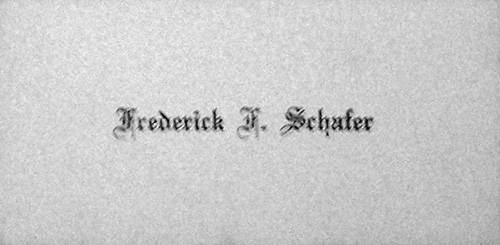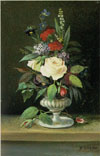The artist
Much of what is known about the artist has been discovered in nineteenth century newspaper articles, reports, and advertisements. Thanks to modern technology and projects to scan and index newspaper archives it has become feasible to mount a wide-ranging search for such materials. Furthermore, since those sources have long since entered the public domain, in addition to citing them as sources, it is possible to include images of those clippings. In this section and the sections that follow the reader will find many links to original images.Background
 |
| The artist circa 1903 |
 |
| Said to be the artist's easel |
Frederick Ferdinand Schafer was a nineteenth-century western United States landscape artist not well known outside of a community of collectors and dealers of western art, mostly in California and the Pacific Northwest. Schafer is listed with a brief biographical sketch in the standard reference encyclopedias that list artists of the American West, and exhibition catalogs typically succeed in filling out about one paragraph of biographical information, mostly by repeating things from earlier exhibition catalogs.1 The information found in the biographical encyclopedias, in the California Artists Archive of The Oakland Museum of California, in the exhibition catalogs, in nineteenth-century newspaper accounts, and in notes and letters of collectors, is fragmentary and in some cases contradictory. No one has reported uncovering any original papers or diaries, and information about his artistic training is largely a matter of conjecture. Even Schafer's Vital statistics appear in print with wide variations.
There seems to be agreement that Schafer was born in 1839 in Prussia (modern-day Germany), but there are competing claims as to the birthdate and birthplace. A German parish record of a Friedrich Ferdinand Schäfer, born 25 November 1839 in Zorbau, Weißenfels, Prussia, likely refers to the artist, though it could refer to someone else who shares the same name. The artist's death certificate, which was informed by his daughter Eda, gives a birthday 3 months earlier, on 16 August, which is probably when his family celebrated his birthdays. As to birthplace, the artist's grandson, Frederick O. Hughes, reported in a circa 1975 interview with William K. Dick that Schafer was born in Braunschweig, a city located about 200 kilometers northwest of Zorbau. An 1871 ship manifest lists Braunschweig as Schafer's residence at the time of sailing, but that does not say anything about his birthplace. That record may be the source of the birthplace claim.
 |
| The artist's calling card |
Both the German parish record and the German ship manifest indicate that Schafer's name in his native land was spelled "Friedrich Ferdinand Schäfer". U.S. official documents (at least the ones that have been located) and his calling card all use the anglicized spelling "Frederick Ferdinand Schafer", suggesting that he adopted that spelling upon immigration.
On the other hand, Schafer signed his paintings both with and without an umlauted "a" in his surname (and occasionally with the umlauted "a" rendered in the conventional English transliteration "ae"). Some biographical sources2 claim that Schafer spelled his name several ways in signatures on paintings, but apart from a few paintings that seem to have had signatures added later by other hands, no other spellings have turned up in this inventory. Nineteenth century newspaper articles and advertisements occasionally omit the "c" or double the "f" in his surname, but these variations should probably be attributed to sloppy newspaper editing.3
By all reports, Schafer's career as an artist was troubled. He seems to have arrived in San Francisco at the worst possible time. There were dozens of other landscape artists already working in the city in the 1880's.4 San Francisco collectors felt that in order to be properly sophisticated they should be acquiring European, rather than local, work.5 To cap it off, a series of financial panics in the last quarter of the nineteenth century must have cut into the cash available for patronizing artists.6 A reporter for the Los Angeles Times in 1886 said about a sale of Schafer paintings that a great many paintings "were sold…for about the cost of the frames."
Schafer apparently was somewhat bitter about these circumstances, as indicated in his strongly negative comments in both an 1886 newspaper feature about the world of art in San Francisco and also in a newspaper interview. To keep dinner on the table he augmented his income both by painting theatre scenery and by teaching painting. In the above-mentioned interview, Schafer's grandson said that Schafer painted theatre scenery for the Ye Liberty and Columbia theatres in Oakland. Confirmation of Schafer's scenery painting is found in a newspaper preview of a play at the Baldwin theatre in San Francisco, and also in a report of a play at the Burbank theatre in Los Angeles.
Schafer's efforts to teach painting are recorded in an 1882 advertisement and newspaper notices that appeared in several other cities (for example, Salt Lake City and Seattle) where Schafer visited to sketch and sell paintings. A 1910 advertisement, when Schafer was 71 years of age, offers not only lessons in drawing and painting but also "amateurs' work finished", which may explain some strange paintings that have emerged.
Training
Two lines of investigation suggest that Schafer studied in Germany, at Düsseldorf, though apparently not at the Düsseldorfer Malerschule. First, his work resembles that of Düsseldorf-trained painters. The section of these notes on Similarities, affinities, and influences explores this line of investigation in some depth.
Second, several nineteenth century newspaper articles and auction advertisements mention Düsseldorf in connection with Schafer, and some identify him as "Professor". A typical reference to a Düsseldorf background can be found in the opening line, "Professor Frederick Schafer of Dusseldorf…", in the (Salt Lake City) Daily Tribune in 1891. The article continues with effusive compliments on Schafer's painting ability that read more like a press release than a news story, suggesting that the source is likely Schafer himself. Similarly, the Los Angeles Times in 1886 refers to "…paintings by Professor F. Schafer, a graduate of the Dusseldorf school…" and subsequently several times again refers to the artist as "Prof. Schafer". In the same year The (Salt Lake City) Daily Tribune again identifies him as "Prof. Schafer". The Vancouver Daily World in 1891 begins a news item "Prof. Frederick Schafer of Dusseldorf…" and in subsequent days again refers to "Prof. Schafer". Auction advertisements in 1885 in the San Francisco Chronicle also refer to the artist as "Prof. Frederick Schafer". These and other clippings suggest that Schafer represented himself as being trained, and perhaps even a teacher, at Düsseldorf.
However, there seem to be no records of his attendance there nor of residence in the area. A personal communication of 30 October 1991 from Dr. Volker Adolphs, of the Kunstmuseum Düsseldorf im Ehrenhof reports that Dr. Adolphs reviewed records of the Düsseldorfer Malerschule and also local government archives, and was unable to find any mention of a Frederick (or Friedrich) F. Schäfer.
 [Floral still life: white rose] |  [Floral still life: red rose] |
1. Biographical sketches can be found in Dawdy, Doris Ostrander, Artists of the American West, pages 389-390; Samuels, Peggy and Harold, The Illustrated Biographical Encyclopedia of Artists of the American West, page 422; Hughes, Edan Milton, Artists in California, 1786–1940(2002), page 1007; and Sharylen, Maria, Artists of the Pacific Northwest, page 178. The shortage of information about the artist is remarked on in Campbell, Catherine H., New Hampshire Scenery, page 136. A biographical sketch in Falk, Peter Hastings, ed., Who Was Who in American Art 1564–1975 (1999 edition, volume 3, page 2912) is somewhat longer and benefits from recent historical research.
A thorough search of Thieme, Ulrich, Allgemeines Lexikon der bildenden Künstler von der Antike bis zur… (Vol. 29, pages 549f) uncovers four different Frederick Schäfers (in various spellings) but not this artist. The Vollmer, Hans, Allgemeines Lexikon der bildenden Künstler des XX Jahrhunderts supplements to Thieme in 1958 (Volume 4, page 171) and 1962 (Volume 6, page 396) also show no listing. Similarly, Bötticher, Friedrich von, Malerwerke des Neunzehnten Jahrhunderts and Benezit, Emmanuel, Dictionnaire Critique et Documentaire des Peintres,… have no listing for this artist. The supplement to Mallett's 1948 Index of Artists on page 247 lists a Friedrich Schäfer with a birthplace of "Braunsching," Germany, in 1869 (30 years after the birth of our subject), giving references to Thieme and Benezit, but neither of these sources has such a listing in any edition examined.
2. Comments about Schafer's signature spellings may be found, for example, in Baird, Joseph Armstrong Jr., Catalog of…the…Honeyman…Collection, page 131, and Hughes, Edan Milton, Artists in California, 1786–1940, second edition, page 494.
3. An example of the umlaut is found in an 1886 "Art Notes column" in the The San Franciscan. Another example of an accent (using the form "Scháfer", perhaps because the font case lacked an unlauted "a") may be found in an 1884 auction advertisement in the The Argonaut.
4. Langley's San Francisco Directory for 1881 under the category "painters, landscape and marine," (page 1122) includes Schafer in a list of forty names.
5. See, for example, the excerpt from page 416 of Lloyd, Benjamin E., Lights and Shades in San Francisco.
6. There were financial panics in 1879, 1885, 1888, 1891, 1894, and 1897. See, e.g., The Wall Street Journal, November 5, 1991, page A5.